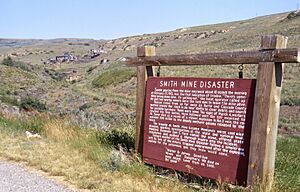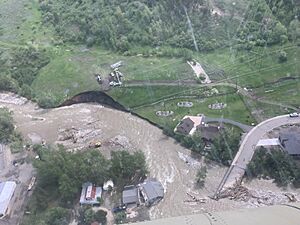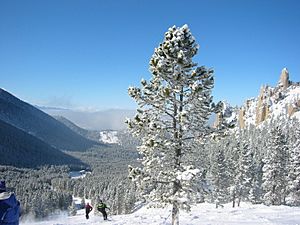Red Lodge, Montana facts for kids
Quick facts for kids
Red Lodge, Montana
|
|
|---|---|

Main Street (2000)
|
|

Location within Carbon County and Montana
|
|
| Country | United States |
| State | Montana |
| County | Carbon |
| Area | |
| • Total | 2.71 sq mi (7.03 km2) |
| • Land | 2.71 sq mi (7.03 km2) |
| • Water | 0.00 sq mi (0.00 km2) |
| Elevation | 5,588 ft (1,703 m) |
| Population
(2020)
|
|
| • Total | 2,257 |
| • Density | 832.23/sq mi (321.27/km2) |
| Time zone | UTC-7 (Mountain (MST)) |
| • Summer (DST) | UTC-6 (MDT) |
| ZIP code |
59068
|
| Area code | 406 |
| FIPS code | 30-61525 |
| GNIS ID | 2411529 |
Red Lodge is a city and county seat of Carbon County, Montana, United States. As of the 2020 census, the population of the city was 2,257.
Contents
History
On September 17, 1851, the United States government signed a treaty with the Crow Nation, confirming control of the area which now contains Red Lodge, MT to the Crow Indians. Rich coal deposits were found there in 1866, and gold was discovered nearby in 1870. An 1880 treaty between the U.S. government and the Crow allowed the area to be settled starting April 11, 1882.
The Red Lodge post office was established on December 9, 1884, with Postmaster Ezra L. Benton. A rail line was constructed into town, and coal shipments began in June 1889. The boundaries of the Crow Reservation were redrawn October 15, 1892, opening the whole area to settlement. From then until the 1930s, coal mining defined the town.
In the late 19th century, many new settlers came to Red Lodge, MT. The majority came from Italy, the British Isles, Finland, Norway, Sweden, Germany, and Austria-Hungary. By the mid-1880s, migrants were still outnumbered by large numbers of Native Americans. By 1892 the population reached 1,180.
In 1896, Red Lodge had twenty saloons and, as the library records show, riotous and violent living was characteristic of the town. By 1906 the population had grown to 4,000 and by 1911 this had increased to 5,000.
Red Lodge suffered in the Great Depression, which forced many mines to close. To offset this downturn, the manufacture of illegal bootleg liquor, labeled syrup, became an economic mainstay and was sold as far away as Chicago and San Francisco.
In 1931 work began on the Beartooth Highway linking Red Lodge to Yellowstone National Park; it was officially opened in 1936.
In 1943 tragedy hit Smith Mine #3 near Bearcreek, the area's largest remaining mine. An explosion trapped and killed 74 men with only three of the workers in the mine that day escaping, making it the worst coal mine disaster in Montana's history. The mine was shut down shortly thereafter but was reopened in the late 1970s. The Red Lodge cemetery contains a memorial.
The downtown has been redeveloped since the mid-1980s for historic and cultural tourism, as the Red Lodge Commercial Historic District. The buildings in downtown Red Lodge fell into disrepair in large part because population had dropped from its 1915 peak of 6,000 people to about 2,000.
As of 2006, an estimate suggests that the population of Red Lodge may increase from about 1,200 people in the winter to over 1,800 people during the summer tourist season, arriving via the Beartooth Highway.
Red Lodge was heavily affected by the 2022 Montana floods.
Geography
Red Lodge is located adjacent to the Beartooth Mountains just to the south. Rock Creek flows along the eastern border. About 30 miles to the southwest of town, in the Custer Gallatin National Forest, is Granite Peak, the highest point in Montana. Grizzly Peak, of the Red Lodge Mountain ski area, is one of several mountains surrounding the town.
According to the United States Census Bureau, the city has a total area of 2.80 square miles (7.25 km2), all land.
Climate
Red Lodge experiences a continental climate (Köppen Dfb) with cold, somewhat dry winters and warm, wetter summers. Summers are cooler than in areas of Montana further north, due to the high elevation. Winters however, are milder than areas further to the east due to the chinook wind influence, as with most of Montana.
| Climate data for Red Lodge, Montana, 1991–2020 normals, extremes 1894–present | |||||||||||||
|---|---|---|---|---|---|---|---|---|---|---|---|---|---|
| Month | Jan | Feb | Mar | Apr | May | Jun | Jul | Aug | Sep | Oct | Nov | Dec | Year |
| Record high °F (°C) | 70 (21) |
70 (21) |
72 (22) |
80 (27) |
88 (31) |
96 (36) |
101 (38) |
98 (37) |
97 (36) |
86 (30) |
80 (27) |
71 (22) |
101 (38) |
| Mean maximum °F (°C) | 53.9 (12.2) |
54.3 (12.4) |
61.6 (16.4) |
70.5 (21.4) |
77.9 (25.5) |
85.2 (29.6) |
90.9 (32.7) |
90.0 (32.2) |
85.5 (29.7) |
74.7 (23.7) |
61.5 (16.4) |
54.6 (12.6) |
91.5 (33.1) |
| Mean daily maximum °F (°C) | 37.5 (3.1) |
36.7 (2.6) |
45.7 (7.6) |
53.3 (11.8) |
62.0 (16.7) |
71.6 (22.0) |
81.2 (27.3) |
80.6 (27.0) |
71.2 (21.8) |
56.4 (13.6) |
43.1 (6.2) |
35.7 (2.1) |
56.3 (13.5) |
| Daily mean °F (°C) | 25.7 (−3.5) |
25.5 (−3.6) |
33.7 (0.9) |
40.9 (4.9) |
49.3 (9.6) |
57.6 (14.2) |
65.6 (18.7) |
64.7 (18.2) |
56.4 (13.6) |
43.9 (6.6) |
32.1 (0.1) |
25.0 (−3.9) |
43.4 (6.3) |
| Mean daily minimum °F (°C) | 13.9 (−10.1) |
14.3 (−9.8) |
21.7 (−5.7) |
28.5 (−1.9) |
36.6 (2.6) |
43.7 (6.5) |
49.9 (9.9) |
48.7 (9.3) |
41.6 (5.3) |
31.4 (−0.3) |
21.2 (−6.0) |
14.2 (−9.9) |
30.5 (−0.8) |
| Mean minimum °F (°C) | −9.9 (−23.3) |
−8.7 (−22.6) |
−1.5 (−18.6) |
12.9 (−10.6) |
23.7 (−4.6) |
31.2 (−0.4) |
40.9 (4.9) |
37.5 (3.1) |
28.3 (−2.1) |
12.4 (−10.9) |
−2.3 (−19.1) |
−9.7 (−23.2) |
−20.4 (−29.1) |
| Record low °F (°C) | −38 (−39) |
−42 (−41) |
−30 (−34) |
−10 (−23) |
7 (−14) |
20 (−7) |
30 (−1) |
22 (−6) |
8 (−13) |
−13 (−25) |
−25 (−32) |
−42 (−41) |
−42 (−41) |
| Average precipitation inches (mm) | 0.84 (21) |
1.14 (29) |
1.78 (45) |
2.77 (70) |
4.72 (120) |
2.59 (66) |
1.45 (37) |
1.01 (26) |
1.63 (41) |
2.34 (59) |
1.39 (35) |
1.00 (25) |
22.66 (574) |
| Average snowfall inches (cm) | 13.5 (34) |
19.4 (49) |
20.2 (51) |
25.5 (65) |
6.2 (16) |
0.6 (1.5) |
0.0 (0.0) |
0.0 (0.0) |
2.1 (5.3) |
17.0 (43) |
18.7 (47) |
18.7 (47) |
141.9 (358.8) |
| Average precipitation days (≥ 0.01 in) | 4.6 | 4.8 | 7.1 | 9.3 | 12.1 | 11.4 | 9.9 | 8.1 | 7.1 | 6.6 | 5.7 | 5.7 | 92.4 |
| Average snowy days (≥ 0.1 in) | 5.1 | 5.2 | 6.1 | 5.5 | 2.5 | 0.4 | 0.0 | 0.0 | 0.7 | 3.1 | 5.0 | 5.8 | 39.4 |
| Source 1: NOAA | |||||||||||||
| Source 2: National Weather Service | |||||||||||||
Demographics
| Historical population | |||
|---|---|---|---|
| Census | Pop. | %± | |
| 1890 | 624 | — | |
| 1900 | 2,152 | 244.9% | |
| 1910 | 4,860 | 125.8% | |
| 1920 | 4,515 | −7.1% | |
| 1930 | 3,026 | −33.0% | |
| 1940 | 2,950 | −2.5% | |
| 1950 | 2,730 | −7.5% | |
| 1960 | 2,278 | −16.6% | |
| 1970 | 1,844 | −19.1% | |
| 1980 | 1,896 | 2.8% | |
| 1990 | 1,958 | 3.3% | |
| 2000 | 2,177 | 11.2% | |
| 2010 | 2,125 | −2.4% | |
| 2020 | 2,257 | 6.2% | |
| source: U.S. Decennial Census |
|||
Red Lodge is part of the Billings Metropolitan Statistical Area.
2010 census
As of the census of 2010, there were 2,125 people, 1,082 households, and 513 families residing in the city. The population density was 758.9 inhabitants per square mile (293.0/km2). There were 1,675 housing units at an average density of 598.2 per square mile (231.0/km2). The racial makeup of the city was 96.3% White, 0.4% African American, 0.6% Native American, 0.3% Asian, 0.1% Pacific Islander, 0.6% from other races, and 1.6% from two or more races. Hispanic or Latino of any race were 1.9% of the population.
There were 1,082 households, of which 19.5% had children under the age of 18 living with them, 35.6% were married couples living together, 8.2% had a female householder with no husband present, 3.6% had a male householder with no wife present, and 52.6% were non-families. 43.8% of all households were made up of individuals, and 14.4% had someone living alone who was 65 years of age or older. The average household size was 1.92 and the average family size was 2.62.
The median age in the city was 47.3 years. 16.8% of residents were under the age of 18; 6.4% were between the ages of 18 and 24; 22.8% were from 25 to 44; 34.4% were from 45 to 64; and 19.8% were 65 years of age or older. The gender makeup of the city was 49.4% male and 50.6% female.
Education
Red Lodge is served by three public schools: Mountain View Elementary School, Roosevelt Middle School, and Red Lodge High School. For the 2021-2022 school year, there were 319 students enrolled in kindergarten to 8th grade. The high school, 9th to 12th grade, had 180 students. The team name for Red Lodge schools is the Rams.
Red Lodge Carnegie Library serves the area.
The Yellowstone Bighorn Research Association's Geology Field Station is located south of Red Lodge.
Outdoor recreation
Red Lodge is well known for many outdoor recreation opportunities: skiing, mountain biking, fly fishing, and backpacking are nearby. They are home to the national skijoring finals.
Infrastructure
U.S. Route 212 runs through the town from north to south. South of town it becomes Beartooth Highway, a National Scenic Byway. Montana Highway 78 enters west of town from Columbus to the north. Secondary Highway 308 connects the town east to Belfry.
Red Lodge Airport is a public use airport located adjacently on the (1.85 km) westside of town. The nearest commercial airport is Billings Logan International Airport.
The Beartooth Billings Clinic provides medical care for the area. Services include emergency, same-day care, mental health and primary care.
Media
Radio
- KMXE FM 99.3
Newspapers
- Carbon County News (Weekly)
- The Local Rag (1991-2019)
- Red Lodge Pickett (1892-1922)
Notable people
- Doug Brown, long-distance runner
- Brady Canfield, Bronze medal winner in the 2003 FIBT World Championships in skeleton racing
- Kim Gillan, former Montana State Senator and 2012 candidate for the U.S. House of Representatives
- John Johnston was elected the first marshal in Red Lodge in 1888.
- Laurie Niemi, Washington Redskins offensive tackle
- Alice Greenough Orr, internationally renowned rodeo performer
- Gary D. Robson, author and closed captioning innovator
- Emily E. Sloan, lawyer and author
- K. Ross Toole, Montana historian
See also
 In Spanish: Red Lodge (Montana) para niños
In Spanish: Red Lodge (Montana) para niños






